Reed bed is a rare habitat found where the water level is above ground for most of the year, e.g. in floodplains, waterlogged depressions or estuaries, and around lakes. It is dominated by the common reed (Phragmites australis), but also has many other tall flowering plants which are adapted to growing in wet conditions.
There are two types of reed bed:
- Reed swamp, which is permanently waterlogged.
- Reed fen – where the water level is below the ground surface in summer. Reed fen has a more botanically diversity.
Historical info about Reed bed
Between 1945 and 1990 Reed bed decreased at up to 40% in the UK. Currently there are only 3228 ha in Northern Ireland. Reed beds in Northern Ireland tend to occur in relatively small areas and this recorded figure may include a significant proportion of stands less than 0.5 ha or less than 5m.
Species living in and around Reed bed
Reed bed is the most important habitat for birds in the UK, and also supports many other animals including otters and the water vole. Unusual bird species which breed in this habitat in Northern Ireland include the water rail, reed bunting and the reed warbler. For roosting and feeding the hen harrier, starling, swallow and sand martin are found. Reed Beds are important habitats for Invertebrates (species without a spine): Over 700 species of invertebrates have been recorded from reed dominated plant communities, some of which are extremely rare throughout Britian. Reed beds are also a refuge for shoals of young fish and an important food source for them. Plant life – Reedbeds are home to a number of rare plants in Northern Ireland, such as cowbane, march pea and marsh fern.
They are a natural filtration system for waste water. Currently there are a number of schemes looking at reed bed technology for a variety of purposes, e.g. treatment of sewage, industrial effluent, agricultural run-off etc.
Threats to Reed bed
- Drainage: Lowered water levels results in reed beds drying out and allows other vegetation which prefers drier conditions to take over .
- Excessive water extraction for tap water can also dry out the habitat.
- Pollution: dumping of building rubble as well as agricultural and domestic waste into Reed beds in Northern Ireland is a frequent occurrence. This can lead to changes in the composition of the plant life and insect communities
- toxic chemicals from spray drift or run off from agricultural land leads to loss of fish and death of reeds
- Industrial and urban development can lead to breaking up of the habitat, and reduction of existing reed bed areas.
- Climate change could lead to change of species and loss of diversity of reed beds

